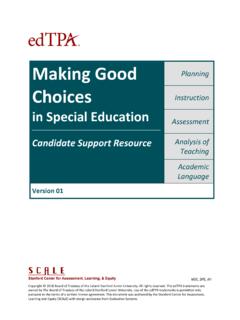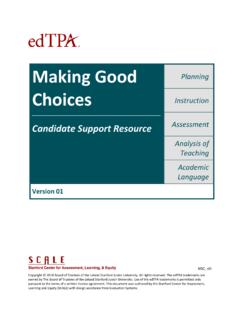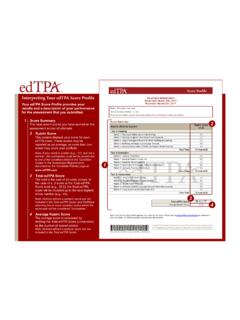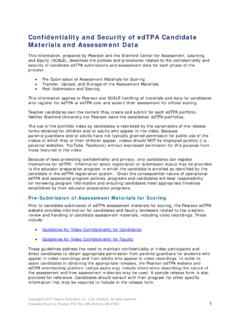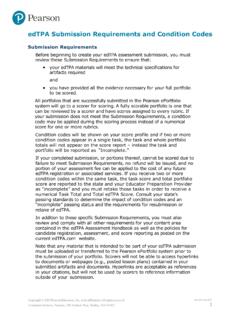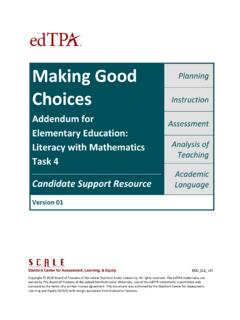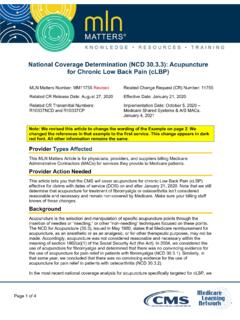Transcription of Making Good Choices - edTPA
1 MGC_ v01 Copyright 2018 Board of Trustees of the Leland Stanford Junior University. All rights reserved. The edTPA trademarks are owned by The Board of Trustees of the Leland Stanford Junior University. Use of the edTPA trademarks is permitted only pursuant to the terms of a written license agreement. This document was authored by the Stanford Center for Assessment, Learning and Equity (SCALE) with design assistance from Evaluation Systems. Making good Choices _____ Candidate Support Resource Planning Instruction Assessment Analysis of Teaching Academic Language Version 01 edTPA Making good Choices Candidate Support Resource Copyright 2018 Board of Trustees of the Leland Stanford Junior University. 1 All rights reserved Table of Contents Introduction .. 1 Getting Started .. 2 Planning Task 1: Planning for Instruction and Assessment .. 9 Instruction Task 2: Instructing and Engaging Students in Learning.
2 18 Assessment Task 3: Assessing Student Learning .. 27 Introduction1 This support guide will help you make good Choices as you develop artifacts and commentaries for your edTPA assessment. This document is not a substitute for reading the handbook. Instead, it should be used as a reference where you can find supplementary advice for completing specific components of edTPA as needed. On the pages that follow, each section of this document addresses key decision points that you will encounter as you complete your edTPA . Use the live links from the questions in the Key Decisions chart to locate the corresponding answers. Bold text provides specific directions to help guide your decision- Making . Overall, Making good Choices examines edTPA tasks within an interactive cycle of planning, instruction, and assessment. This document will help you think about how to plan, instruct, assess, and reflect on student learning, not only for completing edTPA , but also for effective teaching into the future.
3 We encourage you to discuss areas where you need additional support with your teacher preparation instructors and examine relevant Making good Choices sections together. 1 This version of Making good Choices has been developed for all edTPA fields and replaces earlier versions posted on the and websites. However, candidates completing edTPA in Special Education and Elementary Education Task 4 are provided with another version of Making good Choices , which addresses requirements in Special Education and Elementary Education Task 4 separately. Contact your faculty advisor for a copy of the Making good Choices in Special Education or Elementary Education or go to SCALE recognizes Nancy Casey and Ann Bullock for their contributions to Making good Choices in 2014 and 2015, respectively. edTPA Making good Choices Candidate Support Resource Copyright 2018 Board of Trustees of the Leland Stanford Junior University.
4 2 All rights reserved Getting Started Key Decisions Planning Ahead How do I get started with my edTPA preparation? Organizing What evidence do I have to submit? When should I discuss my Context for Learning, including students with specific learning needs? How do I represent my thinking and teaching in writing? Understanding the Rubrics How do I understand the rubrics? How do the commentary prompts align to rubrics? Planning Ahead How do I get started with my edTPA preparation? Time management is critical to the successful completion of edTPA . Begin planning for your edTPA assessment as soon as possible. Do not procrastinate. Work steadily and regularly. Saving time for revisions and edits will allow you to represent your best thinking in your final portfolio. Since it is important to understand the whole edTPA assessment before you begin, read through the entire edTPA handbook and all of the support materials for your content area before you start working on your edTPA , including any materials you may have been given by your preparation program.
5 The specific subject-area handbook that you will use is determined by your state licensure requirements. Once you have selected the edTPA handbook that fits your licensure needs, be sure that you understand the language of the rubrics so that you understand how your teaching will be assessed. The three tasks that structure edTPA (Planning Task 1, Instruction Task 2, and Assessment Task 3) are connected together. Acquiring a complete understanding of the evidence that you need to submit in Tasks 2 and 3 will help guide you as you plan the learning segment for Planning Task 1. When reading through Instruction Task 2, make a note on what you must include in the video. When reading through Assessment Task 3, note the types of student learning that you will need to assess. Back to Getting Started Key Decisions Chart edTPA Making good Choices Candidate Support Resource Copyright 2018 Board of Trustees of the Leland Stanford Junior University.
6 3 All rights reserved Organizing What evidence do I have to submit? For edTPA , you will submit artifacts ( , information about your Context for Learning, lesson plans, video clips, copies of assessments and materials for your lessons) and written commentaries. Response templates are provided as a structure for organizing your responses to the Context for Learning questions and the three task When completing the commentary response templates, note that there are page limits. The handbook also specifies instances when supplemental information you may be directed to add to the end of commentaries ( , citations of materials from others, transcriptions of inaudible portions of videos, any required translation of materials from another language,3 copies of assessments analyzed) does not count toward those limits. All of the requirements about what to submit (and information about the optional elements) are introduced in the Tasks Overview chart at the beginning of the handbook, and then specified in more detail in the Evidence Chart at the end of the handbook.
7 Read the Evidence Chart and be sure that you understand the requirements and all necessary evidence you must submit before you start working on your edTPA . You may find it helpful to use the Evidence Chart as a checklist to ensure that you have submitted all necessary evidence according to the requirements, including artifact format ( , live hyperlinks to materials are not permitted). Portfolios with missing, inaccessible, or inappropriate evidence will receive condition codes (see the condition codes listed in the Submission Requirements). Back to Getting Started Key Decisions Chart When should I discuss my Context for Learning, including students with specific learning needs? The Context for Learning artifact allows you to describe your school setting along with the particular features of your classroom. It informs scorers about the class you are teaching and the teaching environment along with knowledge about the learning needs of your students and their supports/accommodations.
8 In addition, you will be asked to consider the variety of learners in your class several times throughout the handbook see boxed text below for an example. The boxed text is included to help call your attention to learners who might need different strategies/support to meet their needs relative to the central focus of the learning segment. The list included in the box is not exhaustive; you should consider all students with specific learning strengths and needs. As 2 Three additional templates are provided for the Elementary Education Handbook for a total of seven templates for that subject area. 3 If you are submitting materials in a language other than English, see the Submission Requirements for more detailed translation requirements and guidelines. Requirements vary by subject area. edTPA Making good Choices Candidate Support Resource Copyright 2018 Board of Trustees of the Leland Stanford Junior University.
9 4 All rights reserved appropriate, you should also make connections back to the student needs identified in the Context for Learning Information artifact. Consider the variety of learners in your class who may require different strategies/supports or accommodations/modifications to instruction or assessment. For example, students with Individualized Education Programs (IEPs) or 504 plans, with specific language needs, needing greater challenge or support, who struggle with reading, or who are underperforming students or have gaps in academic knowledge. Back to Getting Started Key Decisions Chart How do I represent my thinking and teaching in writing? Although the rubrics do not address the quality of your writing (and you will not be scored on errors in spelling, grammar, or syntax), you should be mindful that your written work reflects your thinking and your professionalism.
10 Writing errors may change the meaning of your commentaries or cause it to become unclear, so proofreading is essential. When writing your edTPA commentaries, consider the following guidelines: Note the originality requirements included within the edTPA Professional Standards and Submission Requirements. As indicated in the subject-specific edTPA handbooks, you and your teacher preparation instructors can and should discuss how the various aspects of edTPA connect with each other and to your preparation coursework and field experiences, including the placement in which you complete your edTPA portfolio. However, the specific Choices that go into the planning, instruction, and assessment tasks that are part of edTPA should solely reflect your thinking, based upon your knowledge of pedagogy and your students needs. All writing should be your own edTPA uses software to detect plagiarism.
